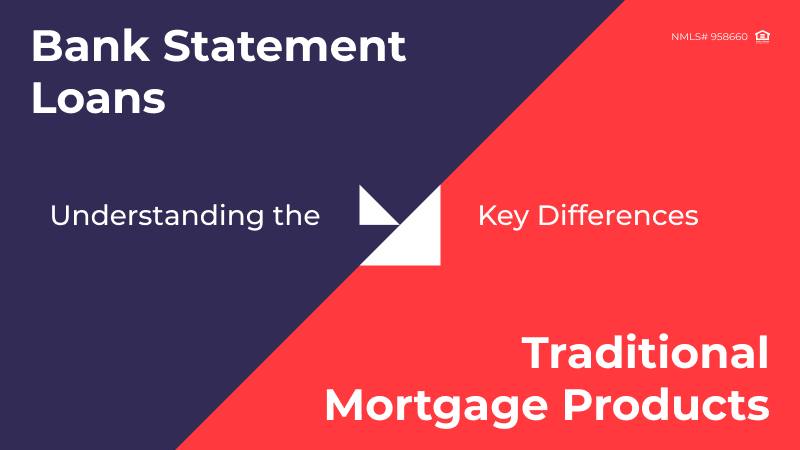
It’s no secret that bank statement mortgage loans can become pivotal solution for non-traditional borrowers, such as self-employed individuals, freelancers, and entrepreneurs, who might not meet the conventional income documentation requirements for traditional loans. This blog post marks the beginning of a comprehensive 4-part series dedicated to unraveling the complexities and opportunities associated with bank statement loans. In this first installment, we delve into effective strategies for mortgage brokers to market their bank statement loan services. Our focus is on identifying and engaging potential clients who could greatly benefit from these loans yet may be unaware of their availability or advantages. Through this series, we aim to equip mortgage brokers with the knowledge and tools needed to navigate the bank statement loan market successfully, ensuring they can cater to a wider, more diverse clientele base.
For mortgage brokers, understanding the nuances between bank statement loans and traditional mortgage products is crucial in advising a diverse range of clients. This comparative analysis delves into interest rates, approval criteria, and suitability to help brokers navigate these options and tailor advice to individual borrower circumstances.
What Are Bank Statement Mortgage Loans?
Looking for a suitable loan program?
Choose among 20+ programs and get
a detailed loan calculation
Bank statement loans are non-traditional mortgage products designed for borrowers who may not qualify for standard mortgages due to the nature of their income documentation. Instead of W-2s and tax returns, lenders evaluate the applicant’s bank statement (typically 12 to 24 months) to assess income and cash flow.
Traditional Mortgage Products
Traditional mortgages, on the other hand, are standard loans offered by banks and other financial institutions where the borrower’s income, credit history, and employment are verified through conventional means like tax returns, W-2 forms, and pay stubs.
Interest Rates
Bank Statement Loans. Generally, these loans carry higher interest rates compared to traditional mortgages. The increased rates compensate for the higher perceived risk associated with non-traditional income verification.
Traditional Mortgages. Interest rates for traditional mortgages are usually lower because the income verification process follows a standardized risk assessment model, making these loans less risky for lenders.
Approval Criteria
Bank Statement Loans:
- Income Verification. Income is verified through bank statement, showcasing cash flow and financial stability.
- Credit Score Requirements. While requirements vary, borrowers typically need a decent credit score, though some lenders may be more lenient given the non-traditional income proof.
- Down Payment. Down payments can be higher than traditional loans, often requiring 10% or more of the purchase price.
Traditional Mortgages:
- Income Verification. Requires standard documentation including W-2 forms, tax returns, and pay stubs.
- Credit Score Requirements. Borrowers usually need a good to excellent credit score to qualify for the best rates.
- Down Payment. Can be as low as 3% for conventional loans, with options like FHA loans offering low down payment requirements for qualifying borrowers.
Suitability
Struggling with a loan scenario?
Get a solution in 30 minutes!Fill out the short form and get your personal offer
Submit a ScenarioBank Statement Loans. Ideal for self-employed individuals, freelancers, and entrepreneurs who have significant income but lack the traditional documentation to prove it. They’re also suitable for those with variable incomes or who take advantage of tax deductions to minimize taxable income.
Traditional Mortgages. Best suited for borrowers with steady, documentable income and a strong credit history. They appeal to salaried employees or those with a consistent work history over the last two years.
Pros and Cons
Bank Statement Loans:
- Pros. Flexibility in proving income, potential for approval despite non-traditional income sources.
- Cons. Higher interest rates, larger down payments required.
Traditional Mortgages:
- Pros. Lower interest rates, potentially lower down payments, and a wider variety of loan products.
- Cons. Strict documentation requirements that may exclude non-traditional earners.
Conclusion
Choosing between a bank statement loan and a traditional mortgage product depends on the borrower’s income type, ability to provide documentation, and their financial goals. Mortgage brokers play a crucial role in guiding clients through this decision-making process. Brokers ensure their clients select the mortgage product that best suits their unique financial situation. Understanding the distinct features, benefits, and limitations of each option allows brokers to offer informed, personalized advice, helping borrowers navigate the path to homeownership with confidence.


